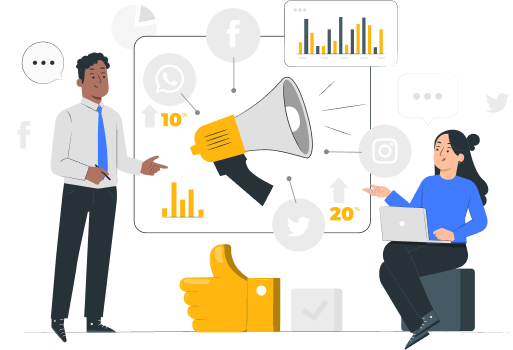Salesforce Pardot’s structured features allow precise user tracking and data-driven marketing. It offers a clear funnel for conversion and loyalty, promoting collaboration with different teams. Pardot’s marketing automation manages the entire inbound marketing journey, from lead generation to brand advocacy. It’s the key to success in modern marketing.
2013 saw the merger of Pardot and Salesforce. At the time, Salesforce’s marketing consisted solely of HTML templates with the phrases “Join us” on the banner and “Campaigns.” That year, Salesforce acquired ExactTarget. At that moment, Pardot was acquired by ExactTarget. As a result, Salesforce quadrupled its purchase, covering both B2B and B2C marketing in the future.
“I hope that the CMO (chief marketing officer) will spend more on technology than the CIO (chief information officer) in 2017,” stated Marc Benioff. The remarks were met with disbelief at the time, but it turns out he was correct. Aligning the marketing and sales departments to avoid duplicating contact with prospects and to optimize resource usage was and remains the main objective. And that worked out well with Pardot.
2013 saw the merger of Pardot and Salesforce. At the time, Salesforce’s marketing consisted solely of HTML templates with the phrases “Join us” on the banner and “Campaigns.” That year, Salesforce acquired Exact Target. At that moment, Pardot was acquired by Exact Target. As a result, Salesforce quadrupled its purchase, covering both B2B and B2C marketing in the future.
“I hope that the CMO (chief marketing officer) will spend more on technology than the CIO (chief information officer) in 2017,” stated Marc Benioff. The remarks were met with disbelief at the time, but it turns out he was correct. Aligning the marketing and sales departments to avoid duplicating contact with prospects and to optimize resource usage was and remains the main objective. And that worked out well with Pardot. Because of its little “Prospects” tag, which could function as a miniature CRM, Pardot was initially a
product that could function independently of a CRM. Although it lacks a lot of data, it does have thorough information, as seen in the “Activities” and “Audit” sections and further details regarding grading and scoring. Above all, though, Pardot was a walking API up until Salesforce restricted it in 2018. It could connect to any CRM, Salesforce or not. From this point on, Pardot could only be connected to Salesforce and could only be connected to a CRM.

Any marketing professional's primary obsession is acquiring new clients, and for good reason. One of a business's primary objectives is acquisition: to draw in potential customers and facilitate their conversion with eye-catching content, efficient landing sites, eye-catching emails, tracked material, forms, etc. With the help of Pardot's features, you can quickly establish origins, create understandable campaign structures, and make it abundantly evident that UTMs are the first line of defense for Pardot. Pardot specializes on cookies and straightforward conversions, which is its area of strength.
Pardot enables us to track a prospect's every move in addition to creating landing pages where the content we wish to deliver may land securely. Let's get off topic and talk about prospects. Everyone in Pardot is treated equally, and the platform does not differentiate between leads and contacts* when determining eligibility. Thanks to codes put into the content we associate with the platform, everyone is a prospect. These codes will also allow us to upload our own HTMLs and construct email templates, and they will eventually serve to correlate all activities with a single prospect. Forms will be covered in the next paragraph.
*Previously, Pardot could tell with complete accuracy if a prospect was a candidate or a contact.
For Pardot, forms are crucial. With this technology, completing a form no longer feels like a transitional experience—rather, it nearly feels interactive. We have the option of filling out forms "on their own," since they have already gathered information about us (progressive profiling), or forms (Forms & Form Handlers) that are linked to Salesforce and include a number of Completion Actions, which trigger events as soon as we hit the enchanted "submit" key. Examples of these actions include receiving an email automatically or being added to a list that will inform a journey. Don't worry if you forget to include a Completion Action; Pardot includes backups, such as Automation Rules, for just such situations.
What happens if you wish to enhance an existing form on your website that sends data to an excel file using Pardot's features? You can connect it to the tool by using a "code" that offers the endpoint "by Form Handler," which is the solution. Everything is located, tracked, and prepared for conversion; nothing gets away. Furthermore, the prospect is added to lists to initiate communication and the appropriate parties are notified when it enters the system—Sales/Call Center or Owners in Salesforce.
Perhaps another of a marketing professional's primary obsessions is loyalty. It deals with meeting a prospect's needs while also preserving the relationship and making adjustments for new requirements.
Pardot accomplishes this through an ardent journey known as Engagement Studio, which enables us to lead the individual who sent us the email down a path where we can use Pardot to automatically send an email based on whether or not they clicked, which websites they visited, and whether or not they viewed a particular piece of content. Alternatively, if they are on a list that has already been filled up and registered. To analyze every encounter and guide your prospect down the most advantageous path, you can design journeys. The Engagement Studio tool is among the best available in Pardot.
Pardot is centered on the business-to-business (B2B) market, and while marketing is always aimed at individuals, Account Based Marketing (ABM) is here to stay. In B2B strategies, it is crucial to remember that we are speaking about corporations and that we want to align ourselves with their demands regardless of who they are.
One of Pardot's pillars is the marriage of sales and marketing. In order to do this, we can assign points (grading and scoring) to our prospects who, as a result of Pardot's integration with Salesforce, are moved to the commercial department already qualified (MQL; Marketing Qualified Lead) and are prepared to be converted into clients. This is made possible by automation and the various lead qualification rules. The guidelines that specify when a lead is qualified and when to forward them to sales must come directly from marketing. As a result, we steer clear of pointless commercial endeavors. Marketing's contribution to the commercial side (MQL) will undoubtedly increase the SQL rate (Sales Qualified Lead).
And how do we assess achievement? With the use of Pardot's reporting, you can see who has viewed your landing page, completed the form, clicked on links in your email, and even tracked the actions a prospect made from the moment they were simply an IP address to the moment they gave us their email and began looking through our website. You may view every detail regarding the conversion in Pardot by selecting the "Lifecycle" report under the "Reports" menu. Salesforce also offers us reports and panels that provide us a comprehensive and essential picture of the process, in addition to Pardot's reports. Salesforce and Pardot work best together to guarantee that customer behavior is tracked as efficiently as possible.
The main benefit of utilizing Pardot is marketing process automation, which helps the team work more efficiently and quickly when developing, carrying out, and evaluating effective campaigns. However, there are other ones that are equally significant:

We can build stronger relationships with prospects and engage with them through dynamic campaigns that are tailored to the current stage of the brand relationship thanks to Pardot's high participation level. We can refine every stage of the marketing-to-sales process and gain a deeper understanding of the customer experience. Pardot allows for client tracking at every stage of the funnel and dynamically displays the updated information at this point, letting you know what it is doing and when.

Lead dissatisfaction is a recurring source of conflict between marketing and sales. If the leads that Pardot generates are the proper ones, it will assist you in improving the relationship between the teams. We can make sure that we are categorizing leads based on their familiarity with and interest in the brand or product by using scoring and grading systems. Additionally, we can distribute leads to sales at the optimal time using this score.

This benefit directly follows from the first two points. Prioritizing opportunity management is crucial, and Pardot places a great importance on prospect rating and classification. We can make sure the leads we send to sales are ready using automatic grading, and if we'd want, we can even get real-time phone alerts regarding the leads.

Salesforce Pardot offers clear ROI insights for marketing initiatives. It tracks and highlights successful efforts, enabling increased investment. Pardot's reports provide a holistic view of the sales cycle, prospect location, and Google AdWords impact. It's the ultimate B2B marketing automation within the Salesforce ecosystem, improving client interactions, creating opportunities, and enhancing sales-marketing collaboration. Empire Cloud strongly recommends its implementation.